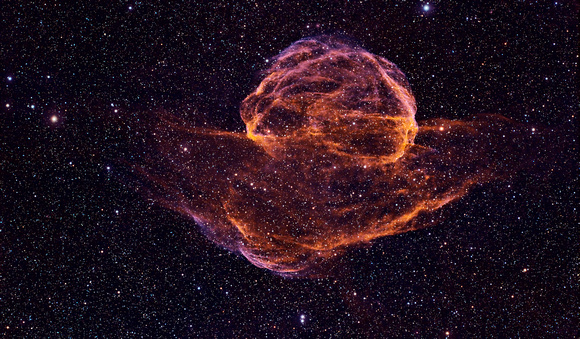Bird's Nest / Rice Hat Supernova Remnant in HOO
Sh2-224 Bird’s Nest / Rice Hat SNR (Auriga) in HOO
Askar 151phq; AP Mach2 GTO
ASI6200MM, - Baader RGB & 6.5nm NB CMOS opt. filters
H,O: (66,61 x 450s, Bin 1, Gain 200)
R,G,B: (27,15,17 x 210s Bin 1, Gain 100) (for stars)
Total integration time = 19.3 hrs
The Bird’s Nest/Rice Hat Nebula (SH2-224 or LBN769 or SNR G166.0+04.3) is a dim supernova remnant (SNR) in Auriga whose shell’s are very characteristic of other SNRs, but whose non-spheriod, grossly asymmetric shape questions the forces that are at play.
The filamentary structure of the shells, and the fact that [OIII] and Ha emissions seem to dominate on different “filaments” are a great indicator that this is indeed an SNR. So too is the apparent fractal bubbliness that the filaments outline.
However, it is difficult to imagine how a single Supernova detonation could result in what appears to be two entirely different, yet overlapping shells. The more southerly shell seems to be very wide and forms the “hat” in the Rice hat. The smaller heart-shaped shell forms the head covered by the hat. The origin point of the supernova, I would guess be along the brim of the hat, where it coincide with the inner point of the heart shaped head.
Two possible explanations are that the head and the heart are the results of two supernova detonations from nearby stars such as is now postulated for the Jellyfish nebula, or the result of stellar winds / relative movement of the interstellar media.
In either case, the object is quite dim, especially compared to the Jellyfish nebula, and was a challenge to capture in the moist Vancouver Island winter conditions. The Jellyfish’s comparative brightness is caused by the presence of much more interstellar material swept up by the supernova, and the abundance of UV energy sources provided by young stars. Both SNRs are about the same age – SH2-224 is between 13,000 and 24,000 years but the relative angular size and part of the brightness difference explained by the fact that the Bird’s Nest / Rice Hat nebula is about 3 times more distant at 14,700 lys.


